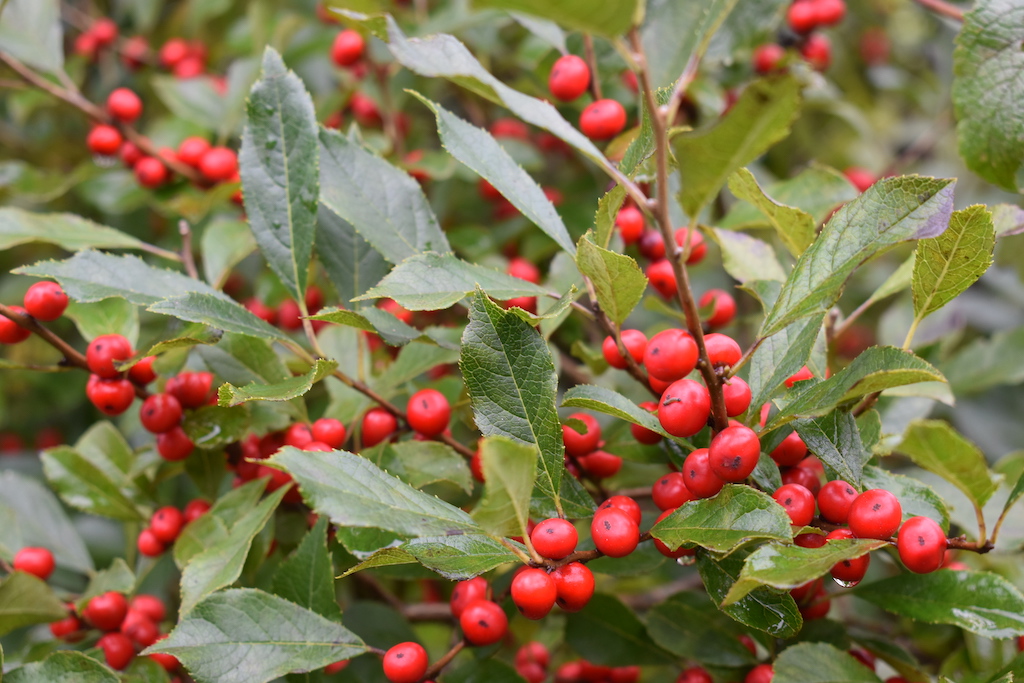
Maine Home Garden News November 2022
In This Issue:
- November Is the Month to . . .
- Procrastination Is a Good Thing
- Keeping Pets Safe Around Indoor Plants
- Brzozowski Retires After More Than 35 Years of Dedication
- Storm Cleanup Reminders
- White Breasted Nuthatch
- Game Review, Kodama: The Tree Spirits
November Is the Month to . . .
By Kate Garland, Horticulture Professional Penobscot County
Hold off on collecting evergreen boughs for holiday decorations until after the trees have experienced at least three consecutive nights at 20 degrees. This will ensure that the needles hold on longer. See the Maine Balsam Fir Tips: A Sustainable Harvest video.
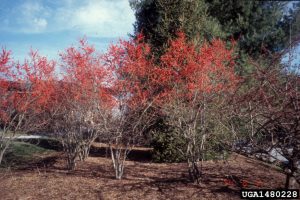
Avoid creating or purchasing holiday decorations that contain invasive species. There are many great alternatives to the tempting orange of bittersweet vines and the little red fruits of multiflora rose. Fruits from common winterberry and staghorn sumac; seed heads from black-eyed coneflower and native grasses; dried flowers; and even the spore fronds of sensitive fern are just a few of countless natural elements to consider for your seasonal creations.
Keep harvesting! If you directly sowed seeds for carrots, spinach, swiss chard, turnips, and beets in early August or planted cabbage and broccoli seedlings at that time, you are no doubt thanking yourselves for these late-season garden treats. Keep row cover over your plantings to stretch out the harvest – hopefully, you’ll be able to enjoy your own home-grown produce during a holiday meal! For more information see Bulletin #2752, Extending the Gardening Season.
Create an ecologically valuable piece of visual art with sticks and twigs that would normally be tossed to the curb or added to the burn pile. Woody “debris”, which can be ubiquitous after fall storms, provides a tremendously important habitat for insects and wildlife. Arranging it artfully can add beauty to the landscape, take care of the mess, and offer a space for insects and other creatures to overwinter. Be inspired by the award-winning “Art Goes Wild” installation by Gary Smith at the Garden in the Woods.
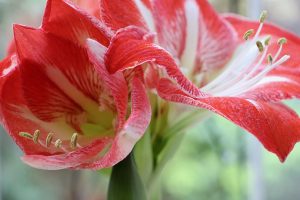 Plant paperwhites and amaryllis bulbs for midwinter enjoyment. This is a great activity to do with loved ones and offers something cheerful to look forward to as the daylight dwindles.
Plant paperwhites and amaryllis bulbs for midwinter enjoyment. This is a great activity to do with loved ones and offers something cheerful to look forward to as the daylight dwindles.
Lastly, make an effort to be outside as much as possible to soak up the dwindling daylight. Getting out into the brisk autumn air will not only do wonders to boost the spirit, but also give you the opportunity to observe what’s still happening in your garden. You might be surprised by what you find.
Procrastination Is a Good Thing
By Nancy Donovan PhD., PT, Master Gardener Volunteer
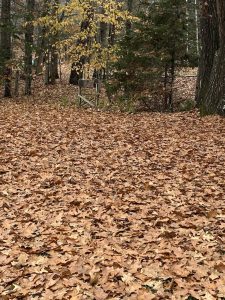 A card on my refrigerator states “If you put things off till the last minute, they only take a minute to do.” I also have a drink coaster that says, “I used to just crastinate, but I got so good, I went pro.” My name would surely be included in any list of the top ten procrastinators in the USA. So, when I first learned about the practice of “Leave the Leaves” I quickly and joyfully shouted, “I’m in.” The next thing I had to do is learn why. My sources include the Xerces Society for Invertebrate Conservation, the National Wildlife Federation, and The Wild Seed Project.
A card on my refrigerator states “If you put things off till the last minute, they only take a minute to do.” I also have a drink coaster that says, “I used to just crastinate, but I got so good, I went pro.” My name would surely be included in any list of the top ten procrastinators in the USA. So, when I first learned about the practice of “Leave the Leaves” I quickly and joyfully shouted, “I’m in.” The next thing I had to do is learn why. My sources include the Xerces Society for Invertebrate Conservation, the National Wildlife Federation, and The Wild Seed Project.
My readings taught me that most butterflies and moths overwinter as eggs, caterpillars, chrysalises, or cocoons. Just this week I saw a Woolly Bear Caterpillar, which will eventually become an Isabella Tiger Moth, exploring one of my perennial beds, looking for the right spot to spend the winter. The black and reddish-brown striped creature will curl and snuggle in piles of leaves for protection from cold and predators. Every time I see a Luna Moth in the spring/summer, I count it as a gift for that day. The Luna Moth spends the winter in a cocoon under leaf litter. Its primary host tree in the north is the white birch. The cocoons actually look like dried leaves. The same is true for the Swallowtail butterfly chrysalis.
Besides helping caterpillars, leaf litter also provides protection for slugs, snails, spiders, beetles, millipedes, centipedes, frogs, and salamanders. The Queen Bumble Bee is known to burrow 1-2 inches into the ground under leaf litter during the winter. Leaf litter includes leaves, twigs, and pieces of bark. The most notable exception to an insect that uses leaf litter for protection during the winter is the Monarch butterfly which we know migrates to Mexico.
To support these wonderful little creatures, leaves in garden beds and at the borders of lawns should be left whole, because shredding them can destroy the eggs, caterpillars, cocoons, and chrysalises. While lawns can tolerate a thin layer of leaves, it may be preferable to rake them off the grass and then apply them around trees, shrubs, and perennials. Leaves will insulate plant roots through the winter months and protect tender roots that may become exposed from frost heaves. According to David Mizejewski, in an article for the October 2015 National Wildlife Federation, “Fallen leaves offer a double benefit . . . [They] form a natural mulch that helps suppress weeds and fertilizes the soil as it breaks down . . . Why spend money on mulch and fertilizer when you can make your own?” By adding nutrients and organic matter, leaves help to build healthy soil.
Another option is to create a pile of leaves, branches, sticks and stems in a corner of your yard. This will provide overwintering shelter for animals and allow the leaves to break down naturally. I appreciated Anna Fialkoff’s description of leaves as a “colorful natural blanket” in an article for the Wild Seed Project titled “Leave the Leaves.”
Do remove leaves from the lawn if they are thick enough to smother the grass. They should also be cleared from sewer drains, driveways, and pedestrian areas, including pathways and sidewalks, where they can cause slipping hazards and impede snow removal.
Procrastination is also fine when it comes to cutting back tall perennials such as grasses, coneflowers, and asters, whose seed heads feed the birds. I smile to see the tops of the plants poking through the snow. I do cut back plants with hollow stems and place them on the ground, where some solitary bees will lay eggs in them and the babes will hatch in the spring.
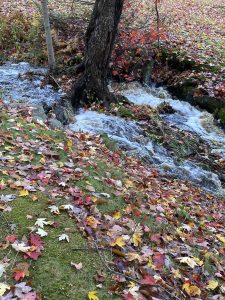 Eager gardeners often start planning for spring clean-up in early February, when Punxsutawney Phil is pulled out of comfortable hibernation to predict the arrival of spring. But gardening experts advise continued procrastination. Justin Wheeler, writing for the Xerces Society, suggests one should start only after the snow shovel has been moved to the back of the garage – Tax Day (April 15) at the earliest. Furthermore, since some bees do not emerge until late May, waiting even longer is best, perhaps until it is time to regularly mow the lawn. You might even want to join the “No Mow May” movement. Again, I shout “I’m in!”
Eager gardeners often start planning for spring clean-up in early February, when Punxsutawney Phil is pulled out of comfortable hibernation to predict the arrival of spring. But gardening experts advise continued procrastination. Justin Wheeler, writing for the Xerces Society, suggests one should start only after the snow shovel has been moved to the back of the garage – Tax Day (April 15) at the earliest. Furthermore, since some bees do not emerge until late May, waiting even longer is best, perhaps until it is time to regularly mow the lawn. You might even want to join the “No Mow May” movement. Again, I shout “I’m in!”
So, when it comes to fall garden cleanup, my advice is “put off till the spring what you planned to do today.” Instead, take the time to view the kaleidoscope of colors as the plants and trees undergo their seasonal transitions, and enjoy an invigorating walk without the ten layers of clothing you’ll need in winter. During a recent walk, I made a mental note to wear the equivalent of a hardhat, as the squirrels seemed to be aiming acorns right at me. If you find yourself looking outside and admiring a beautiful day, don’t procrastinate. Put on your walking shoes right now and step outside to enjoy the many sights and sounds Mother Nature provides. Quickly and joyfully shout, “I’m out!”
Keeping Pets Safe Around Indoor Plants
By Sandra Mitchell, Master Gardener Volunteer
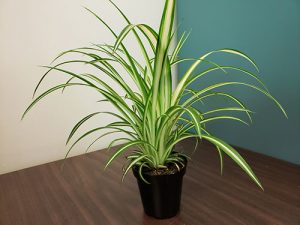 It’s getting to be that time of year – moving the houseplants back indoors after a glorious summer outside. And it is a time of delight for Fluffy and Fido as well – all of these new things to sniff, dig in, and taste! Coming home and finding a scattered mess on the floor is not necessarily the best time to wonder if the decimated plant was pet safe. Plan now to keep your pets safe! It is always a good idea to keep plants up and away from exploring paws and mouths. But, what are the top 10 plants to be most concerned about?
It’s getting to be that time of year – moving the houseplants back indoors after a glorious summer outside. And it is a time of delight for Fluffy and Fido as well – all of these new things to sniff, dig in, and taste! Coming home and finding a scattered mess on the floor is not necessarily the best time to wonder if the decimated plant was pet safe. Plan now to keep your pets safe! It is always a good idea to keep plants up and away from exploring paws and mouths. But, what are the top 10 plants to be most concerned about?
- Lilies – even a small amount of the pollen can trigger kidney failure in cats
- Philodendrons – the calcium oxalate crystals in these plants can result in mouth burns and gastrointestinal irritation
- Oleander – can cause neurologic signs and abnormal heart rhythms
- Aloe – chewing on the plant can result in vomiting, diarrhea, and lethargy
- Chrysanthemum – can cause incoordination and vomiting
- Hyacinth – the bulbs are the most toxic part of the plant if bitten
- Jade plant – chewing on these plants can cause vomiting, depression, and loss of balance
- Sago palm – a highly toxic plant that can trigger fatal liver failure
- Daffodil – all parts of the plant can result in gastrointestinal distress, seizures, and an abnormal heart rhythm
- Asparagus ferns – even brushing up against the plant can cause skin irritation and eating the berries can cause gastrointestinal upset.
 And don’t forget the seasonal plants that might cause problems, including poinsettias, mistletoe, holly, and amaryllis. These plants make a sudden appearance at a busy time of year, meaning your pets might have more time to explore and get into trouble before being noticed!
And don’t forget the seasonal plants that might cause problems, including poinsettias, mistletoe, holly, and amaryllis. These plants make a sudden appearance at a busy time of year, meaning your pets might have more time to explore and get into trouble before being noticed!
So if the worst has happened and your cherished houseplant is chewed to bits but isn’t on this list – what do you do? First, bag up some of the remaining parts of the plant in case poison control or your veterinarian needs to see them. If you know the identification of the plant – you can consult reliable sites like these to check toxicity:
All in all, though – better safe than sorry! Keep smaller plants up high where curious paws and teeth can’t reach them. For floor plants, consider creative options like “indoor invisible fences” to keep Fido and Fluffy at a safe distance. It’s time to enjoy the beauty of our houseplants where they are happiest – in the house! – but a few extra steps can help keep your pets safe, as well.
Brzozowski Retires After More Than 35 Years of Dedication
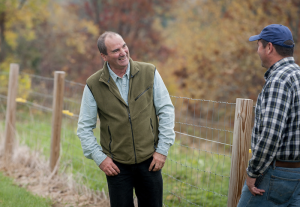 Extension professor Richard Brzozowski retired from the University of Maine Cooperative Extension on October 1, 2022, after more than 35 years of service. Brzozowski started his Extension career by serving as the county agriculture agent (the title now known as Extension Educator) in Cumberland County. He planned, implemented, and evaluated educational programs and applied research projects in Cumberland County and beyond from July 1987 to September 2015. Starting in September 2015, Brzozowski became a member of the Extension Leadership Team when he stepped into the role of Food Systems Program Administrator and began overseeing all of the organization’s agricultural and food-related programs statewide.
Extension professor Richard Brzozowski retired from the University of Maine Cooperative Extension on October 1, 2022, after more than 35 years of service. Brzozowski started his Extension career by serving as the county agriculture agent (the title now known as Extension Educator) in Cumberland County. He planned, implemented, and evaluated educational programs and applied research projects in Cumberland County and beyond from July 1987 to September 2015. Starting in September 2015, Brzozowski became a member of the Extension Leadership Team when he stepped into the role of Food Systems Program Administrator and began overseeing all of the organization’s agricultural and food-related programs statewide.
“Dick Brzozowski epitomizes a servant leader as he has continued to live the 4-H Pledge throughout his career with UMaine Cooperative Extension,” said Hannah Carter, Dean of UMaine Cooperative Extension. “Many of our most popular programs within Extension are due to Dick’s efforts and he certainly will be missed throughout the organization. His passion for both people and programs, dedication to his family and to service, and his profound love of agriculture are why he is leaving a lasting legacy.”
Brzozowski grew up in the small town of Antrim, New Hampshire, the middle child of seven. He couldn’t wait to turn 9 years old and join 4-H. Brzozowski says, “ I vividly remember the day the Hillsboro County 4-H agent, Charlie Buck, came to my home to inspect my sheep project. That visit made a huge impression on me. From that point on, I wanted to be just like Mr. Buck and help kids and adults learn about farming. From my early 4-H days, I set my goal to become an Extension Agent.”
After high school, Brzozowski attended the Thompson School of Agriculture as an animal science major at the University of New Hampshire, where he lived and worked in the livestock barns. “Working in the barns was a great place to learn. However, all my clothing smelled like manure or silage. No one would sit beside me in class or at hockey games due to my zone of repugnance. I finally decided to keep sets of clean clothes in the greenhouse across the road from the barns.”
After graduation, Brzozowski worked on farms in NH including a dairy farm, a sheep farm, and an egg operation. “My pay was $1.50 an hour and it was difficult to save any money. After several months of farm work, I decided to join the Navy because of my dad, a Pearl Harbor survivor, and a long line of relatives who were also US Navy veterans. I joined the Seabees (construction battalion) as a Builder and was deployed to places like Antarctica (where I helped build the research station at the South Pole), New Zealand, Bermuda, the Azores, and Eleuthera, an island in the Bahamas. My Navy training and work experiences in other parts of the world really helped me gain skills and knowledge about construction and, more importantly, about living a full and productive life.”
After the Navy, Brzozowski used the GI Bill to return to school and earn degrees in Applied Fruit and Vegetable Science from Stockbridge School of Agriculture at the University of Massachusetts and then bachelor and graduate degrees in Agriculture Education, Extension Education, and Practical Arts and Vocational Technical Education from the University of Missouri – Columbia.
He started work for the University of Maine on July 15, 1987. His work with UMaine Extension included resurrecting a dormant Master Gardener Program in 1988 and developing programs like farm tractor safety, beekeeping, sheep shearing, Maine Garden Day, Maine Shepherd School, Small Farm Field Day, as well as the Maine Tree Club and Maine AgrAbility. Brzozowski served as the principal investigator for several USDA-funded research projects involving sheep health, forage production, and applied poultry production.
“I owe my successful Extension career to my late wife, Janet Ladd Brzozowski. She put up with my very busy Extension schedule and was so supportive of me in my work. I am very thankful to the Extension staff who worked alongside me including administrative assistants, extension professionals, extension educators, extension specialists, and administrators. In addition, my Extension work would not have been as productive and far-reaching without the dedicated support of extension volunteers. Extension volunteers are energizing and terrific! The staff and volunteers who surrounded me always made me look good. I am grateful to the University of Maine for hiring me and supporting me over my entire career with Extension. I know that I will deeply miss the farmers, gardeners, volunteers, and Extension staff. I see them as my friends. My Extension work has been much more than a job, it’s been a life calling. I am grateful for such a life.”
Storm Cleanup Reminders
Cleaning up storm debris? Here’s what to know.
Storm cleanup can help keep Maine’s forests healthy. Project Canopy, a program of the Department of Agriculture, Conservation and Forestry’s (DACF) Maine Forest Service (MFS), offers tips and helpful advice to property owners.
- Trees and branches on homes and around power lines — Homeowners must find immediate solutions for downed trees and branches. Branches and trees on power lines should be dealt with by calling local power companies. Even if a hanging limb is clear of power and utility wires, homeowners should rely on professionals to assess the severity of the damage before trying to repair or remove the branch
- Injured or damaged trees requiring climbing or chainsaw work — Call a licensed arborist for help. Arborists are tree care professionals trained to assess and correct storm-damaged trees. They also have experience in diagnosing how much of a tree can or should be saved. Homeowners should be wary of those offering fly-by-night emergency tree-cutting services. Always ask for proof of licensing, insurance, and work references. DACF’s Arborist Program has more information about working with arborists.
The MFS reminds everyone that the woody debris created by storm damage may harbor insects or diseases harmful to our forests. Moving that debris can spread pests to new areas.
Be aware that there are rules, known as quarantines, that impact transport of some woody storm debris:
- In addition to the risks it brings to our environment and economy, violation of rules governing debris movement jeopardizes eligibility for federal aid in the event of a disaster declaration.
- Movement of ash tree material (Fraxinus spp.) from areas within the Emerald Ash Borer Regulated Area.
- Movement of Larch (Larix spp., Pseudolarix spp.) from areas within the European Larch Canker quarantine.
- Movement of Hemlock (Tsuga spp.) branch or top material from areas within the Hemlock Woolly Adelgid quarantine.
Damage to trees in storms can make the evidence of forest pests such as the Asian longhorned beetle or hemlock woolly adelgid more visible. If damage from an invasive forest pest is suspected, please take photos and share them with the MFS.
Storm Preparedness Resources
Maine.Gov Alerts
- Subscribe to Maine.gov Citizen System for storm warnings/bulletins and other urgent or emergency updates.
FEMA and MEMA
- MEMA County and Local Emergency Management Contacts
- MEMA Social Media Updates
- FEMA Business Tips
- MEMA Preparedness Library
Small Business Administration (SBA)
- Business Preparation Tips – guidance and support, before and after emergency events.
Other Resources
- NOAA Storm Tracking and Updates
- USDA Maine Farm Service (FSA) Office
- Maine Bureau of Insurance Guide for Farms
UMaine Cooperative Extension Resources
- UMaine Emergency Response Tips
- Emergency Preparedness Series: Food Safety During Power Outage
- Bulletin #1211, Emergency Preparedness Series: Dairy operations
White Breasted Nuthatch
By Doug Hitchcox, Maine Audubon Staff Naturalist
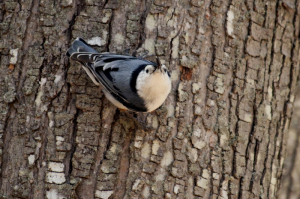
The White-breasted Nuthatch is one of the most charismatic backyard birds. Nuthatches frequently visit feeders, digging through the seeds and tossing aside undesirable selections until they find a good one. They will often take seeds away and cache them in crevices of trees to save for later. They will also wedge large nuts like acorns into bark crevices and hammer them open with their beaks; this is where the name “nuthatch” comes from. Away from feeders, they forage actively on tree trunks and branches for invertebrates like caterpillars and weevils. Unlike woodpeckers, they often descend tree trunks head-first and will hang upside down on branches to search for insects.
For more on the importance of Maine native plants to support birds like nuthatches and other wildlife, visit Maine Audubon’s “Bringing Nature Home” webpage.
Game Review: Kodama: The Tree Spirits
Designed by Daniel Solis, Illustrated by Kwanchai Moriya
Review by Jonathan Foster, UMaine Community Education Assistant
In Kodama (2-5 players, ages 14+), published by Indie Boards & Cards and Action Phase Games, players grow whimsical trees for friendly forest spirits. Building upon trunk bases, players take turns placing branch cards with various features–clouds, fireflies, caterpillars, mushrooms, flowers, and stars–to grow limbs from the trunk. Continuous runs of cards with matching features gain points over 12 turns, through 3 seasons. The player with the most points at the end wins.
To set up, the starting player deals a tree trunk card, player token, and 4 Kodama spirit cards (bearing unique scoring conditions) to each player, then flips 4 branch cards face up from the deck for all to choose from. A Decree card for the spring season establishes a special group scoring condition for the first 4 turns (e.g., doubling points for a certain feature). A new replacement Decree card is turned up for each season.
Players take turns selecting a card (which is then replaced from the deck) from the face-up branch cards and playing it onto their individual trunk, with a few rules: each card may touch only one other, connecting cards must continue a branch, etc. Once placed, cards cannot be moved. Upon placing a card, players score one point for each unique feature on the new card that matches an identical feature on the last card, cascading back as far as the “run” of matching features continues. Multiple runs of features can be counted.
Example: A player plays the uppermost card to their tree, ensuring it only touches one other card and that its orientation “continues” a branch. Because the new card and the previous card below show mushrooms, the player counts one point for each instance of mushroom on the two cards–here, 3. But the card below that also has mushrooms, so it adds 2 more points for a total of 5. Fortunately, the newly placed card and the card below also show stars, so each is counted: 3 more points. That’s as far as the star run goes, though, so the player scores 8 points for the turn.
The Kodama spirit cards offer special scoring conditions similar to the Decree cards, but only for the player who holds them. After 4 turns, each player plays one of these cards as a final Season bonus to their unique tree, hopefully amplifying a feature they have built, representing a unique Kodama spirit who has been enticed to live there because of that feature. Summer and fall repeat the process with a Decree card, 4 turns of play, and Kodama spirits appearing.
Kodama is a pretty little game for experienced gamers and families alike. Players pick up the pattern-making quickly, the tree branching is fun to construct, and the artwork is clever and relaxing. Replayable and portable, Kodama should travel well and make repeat plays as fun as the first time.
For a full walk-through, check out this video, Kodama: The Tree Spirits.
Do you appreciate the work we are doing?
Consider making a contribution to the Maine Master Gardener Development Fund. Your dollars will support and expand Master Gardener Volunteer community outreach across Maine.
Your feedback is important to us!
We appreciate your feedback and ideas for future Maine Home Garden News topics. We look forward to sharing new information and inspiration in future issues.
Subscribe to Maine Home Garden News
Let us know if you would like to be notified when new issues are posted. To receive e-mail notifications, click on the Subscribe button below.
University of Maine Cooperative Extension’s Maine Home Garden News is designed to equip home gardeners with practical, timely information.
For more information or questions, contact Kate Garland at katherine.garland@maine.edu or 1.800.287.1485 (in Maine).
Visit our Archives to see past issues.
Maine Home Garden News was created in response to a continued increase in requests for information on gardening and includes timely and seasonal tips, as well as research-based articles on all aspects of gardening. Articles are written by UMaine Extension specialists, educators, and horticulture professionals, as well as Master Gardener Volunteers from around Maine. The following staff and volunteer team take great care editing content, designing the web and email platforms, maintaining email lists, and getting hard copies mailed to those who don’t have access to the internet: Abby Zelz*, Annika Schmidt*, Barbara Harrity*, Cindy Eves-Thomas, Kate Garland, Mary Michaud, Michelle Snowden, Naomi Jacobs*, Phoebe Call*, and Wendy Roberston.
*Master Gardener Volunteers
Information in this publication is provided purely for educational purposes. No responsibility is assumed for any problems associated with the use of the products or services mentioned. No endorsement of products or companies is intended, nor is criticism of unnamed products or companies implied.
© 2022
Call 800.287.0274 (in Maine), or 207.581.3188, for information on publications and program offerings from the University of Maine Cooperative Extension, or visit extension.umaine.edu.
The University of Maine is an EEO/AA employer and does not discriminate on the grounds of race, color, religion, sex, sexual orientation, transgender status, gender expression, national origin, citizenship status, age, disability, genetic information or veteran’s status in employment, education, and all other programs and activities. The following person has been designated to handle inquiries regarding non-discrimination policies: Director of Equal Opportunity, 101 Boudreau Hall, University of Maine, Orono, ME 04469-5754, 207.581.1226, TTY 711 (Maine Relay System).

